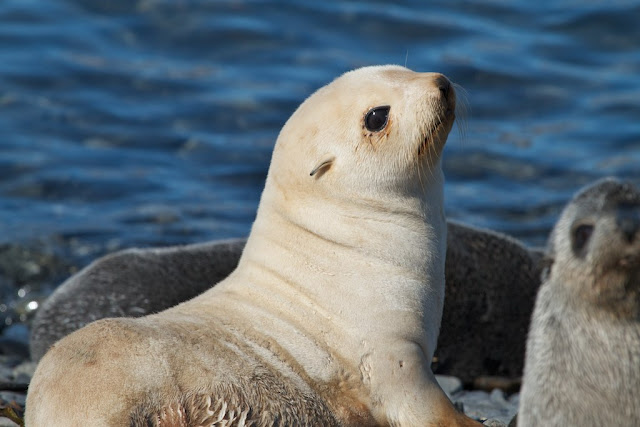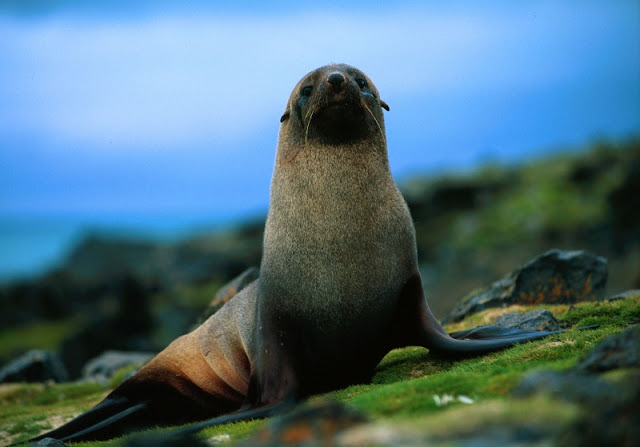Scientific Name: Arctocephalus gazella
Kingdom: Animalia
Phylum: Chordata
Class: Mammalia
Order: Carnivora
Suborder: Pinnipedia
Family: Otariidae
Genus: Arctocephalus
Species: gazella
Average Length: Males – 5 to 6 ½ ft Females – 3 to 5 ft
Average Weight: Males – 190 lbs to 480 lbs Females – 55 lbs
to 155 lbs
The Antarctic fur seal (Arctocephalus gazelle) is one of
nine species of fur seals that, along with six living species of sea lions,
make up the "eared seals" or otariids. Their small external ear flaps
distinguish them from the earless "true seals." The Antarctic fur
seal is the only eared seal that commonly lives in Antarctic waters. They are
seen frequently on TravelWild Antarctica cruises—particularly at sub-Antarctic
South Georgia.
Distribution
Antarctic fur seals can be found in the Antarctic and Subantarctic
waters. Over 95% of the species breed near the coast of South Georgia. They are
also found on several southern islands. Wandering individuals have been found
as far north as Brazil and the Juan Fernández Islands external link.
Antarctic Fur Seal Habitat
When not breeding on land, the Antarctic fur seal leads a
largely pelagic (oceangoing) existence, pursuing its prey wherever it is
abundant. While fur seals are capable of traveling on and hauling out onto ice,
it is unusual to see them there. During the breeding season they primarily
reside on sheltered rocky, sandy and gravelly beaches on sub-Antarctic islands
with lush tussock grass clumps. With available food, some adult males and
juveniles may hang around the breeding islands year-round.
Diet /Feeding
The Antarctic Fur Seal can dive and remain under the water
for up to 10 minutes at a time. They consume large amounts of krill, fish, and
squid while in the water. They are also known to consume small birds while on
land. Many of these types of seals will feed at night due to that being the
best time to find what they are interested in. When they hunt for food really depends
on the location where they live.
Conservation
There aren’t any conservation efforts in place for the
Antarctic Fur Seal at this time. There are more than 4 million of them out
there so that is good news. However, they were once driven to the brink of
extinction in the 18th and 19th centuries. The numbers were able to increase
after they were protected under the Antarctic Treaty. The males have a shorter
life span of approximately 13 years. The females can live up to 25 years.
7 Attractive Antarctic Fur Seal Facts
- Antarctic Fur Seals got their scientific name gazella from the German vessel SMS Gazelle which was the first to collect the Seal from Kerguelen Island.
- Unlike some other species of Seals Antarctic Fur Seal have visible ears. It is the only Seal with visible ears that lives in the Antarctic.
- The area that Antarctic Fur Seals live in is referred to as the “Antarctic Convergence” - a zone of water between the frigid waters of the true Antarctic and the more temperate waters to the north. The area is rich in krill – a major source of nutrients for a wide array of marine life.
- The population of Antarctic Fur Seals on South Georgia Island is the densest marine animal population on the planet.
- Antarctic Fur Seals are one type of nine species of Fur Seals that exist worldwide. They were almost hunted to extinction for their fur (hence the name “Fur Seals”). The near extinction of another animal – baleen whales – may be the main reason the diminutive Antarctic Fur Seal population bounced back, because there was a huge reduction in competition for krill.
- Antarctic Fur Seals are an example of Seals that can walk on land, thanks to their ability to turn their rear flippers forward, turning them into useful “feet.”
- At the turn into the 20th Century only a few hundred Antarctic Fur Seals were found on South Georgia Island due to excessive hunting. Now the species numbers in the hundreds of thousands if not millions during the breeding period.
If You Like,Please Share with Your Friends..



















No comments:
Post a Comment